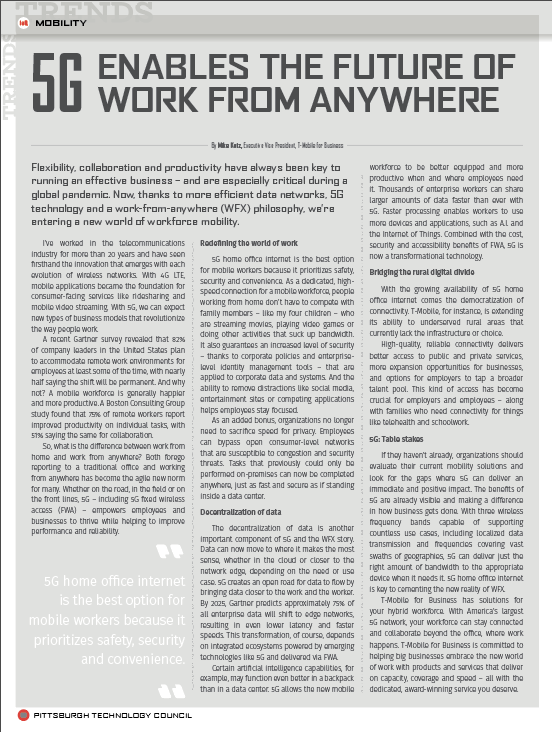 Flexibility, collaboration and productivity have always been key to running an effective business – and are especially critical during a global pandemic. Now, thanks to more efficient data networks, 5G technology and a work-from-anywhere (WFX) philosophy, we’re entering a new world of workforce mobility.
Flexibility, collaboration and productivity have always been key to running an effective business – and are especially critical during a global pandemic. Now, thanks to more efficient data networks, 5G technology and a work-from-anywhere (WFX) philosophy, we’re entering a new world of workforce mobility.
I’ve worked in the telecommunications industry for more than 20 years and have seen firsthand the innovation that emerges with each evolution of wireless networks. With 4G LTE, mobile applications became the foundation for consumer-facing services like ridesharing and mobile video streaming. With 5G, we can expect new types of business models that revolutionize the way people work.
A recent Gartner survey revealed that 82% of company leaders in the United States plan to accommodate remote work environments for employees at least some of the time, with nearly half saying the shift will be permanent. And why not? A mobile workforce is generally happier and more productive. A Boston Consulting Group study found that 75% of remote workers report improved productivity on individual tasks, with 51% saying the same for collaboration.
So, what is the difference between work from home and work from anywhere? Both forego reporting to a traditional office and working from anywhere has become the agile new norm for many. Whether on the road, in the field or on the front lines, 5G – including 5G fixed wireless access (FWA) – empowers employees and businesses to thrive while helping to improve performance and reliability.
Redefining the world of work
5G home office internet is the best option for mobile workers because it prioritizes safety, security and convenience. As a dedicated, high-speed connection for a mobile workforce, people working from home don’t have to compete with family members – like my four children – who are streaming movies, playing video games or doing other activities that suck up bandwidth. It also guarantees an increased level of security – thanks to corporate policies and enterprise-level identity management tools – that are applied to corporate data and systems. And the ability to remove distractions like social media, entertainment sites or competing applications helps employees stay focused.
As an added bonus, organizations no longer need to sacrifice speed for privacy. Employees can bypass open consumer-level networks that are susceptible to congestion and security threats. Tasks that previously could only be performed on-premises can now be completed anywhere, just as fast and secure as if standing inside a data center.
Decentralization of data
The decentralization of data is another important component of 5G and the WFX story. Data can now move to where it makes the most sense, whether in the cloud or closer to the network edge, depending on the need or use case. 5G creates an open road for data to flow by bringing data closer to the work and the worker. By 2025, Gartner predicts approximately 75% of all enterprise data will shift to edge networks, resulting in even lower latency and faster speeds. This transformation, of course, depends on integrated ecosystems powered by emerging technologies like 5G and delivered via FWA.
Certain artificial intelligence capabilities, for example, may function even better in a backpack than in a data center. 5G allows the new mobile workforce to be better equipped and more productive when and where employees need it. Thousands of enterprise workers can share larger amounts of data faster than ever with 5G. Faster processing enables workers to use more devices and applications, such as A.I. and the Internet of Things. Combined with the cost, security and accessibility benefits of FWA, 5G is now a transformational technology.
Bridging the rural digital divide
With the growing availability of 5G home office internet comes the democratization of connectivity. T-Mobile, for instance, is extending its ability to underserved rural areas that currently lack the infrastructure or choice.
High-quality, reliable connectivity delivers better access to public and private services, more expansion opportunities for businesses, and options for employers to tap a broader talent pool. This kind of access has become crucial for employers and employees – along with families who need connectivity for things like telehealth and schoolwork.
5G: Table stakes
If they haven’t already, organizations should evaluate their current mobility solutions and look for the gaps where 5G can deliver an immediate and positive impact. The benefits of 5G are already visible and making a difference in how business gets done. With three wireless frequency bands capable of supporting countless use cases, including localized data transmission and frequencies covering vast swaths of geographies, 5G can deliver just the right amount of bandwidth to the appropriate device when it needs it. 5G home office internet is key to cementing the new reality of WFX.
T-Mobile for Business has solutions for your hybrid workforce. With America’s largest 5G network, your workforce can stay connected and collaborate beyond the office, where work happens. T-Mobile for Business is committed to helping big businesses embrace the new world of work with products and services that deliver on capacity, coverage and speed – all with the dedicated, award-winning service you deserve.